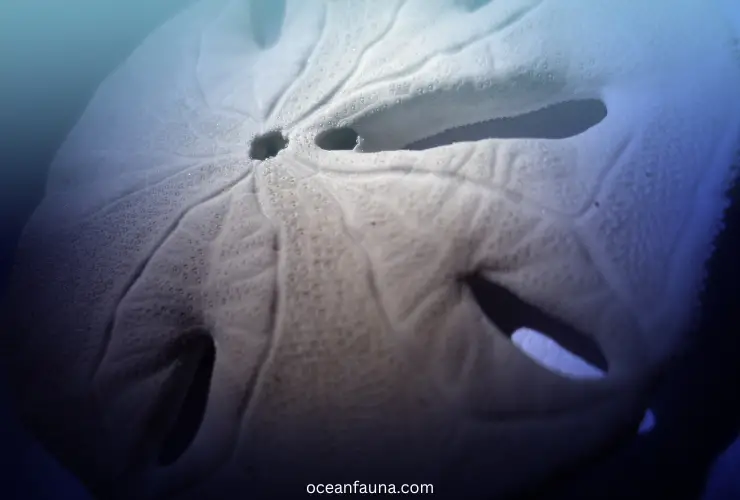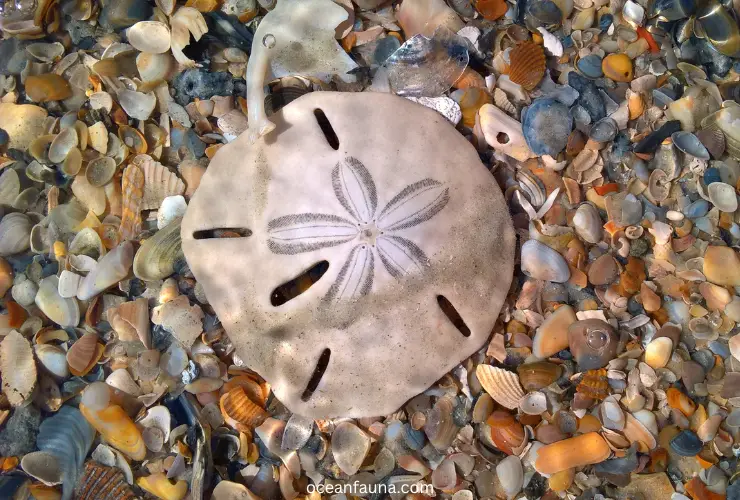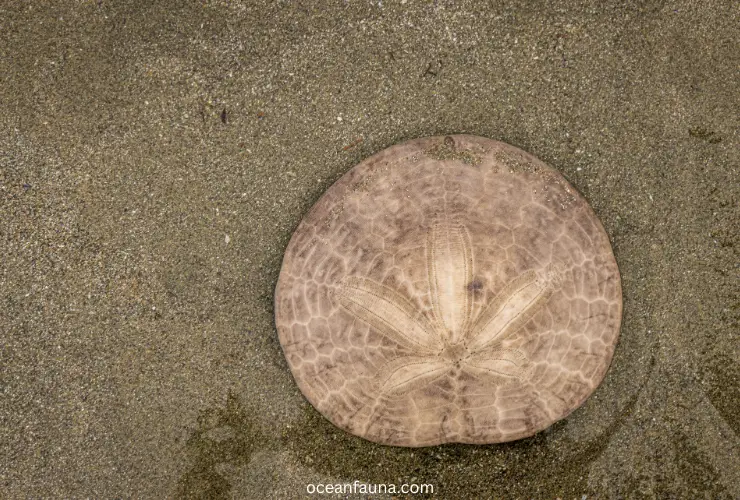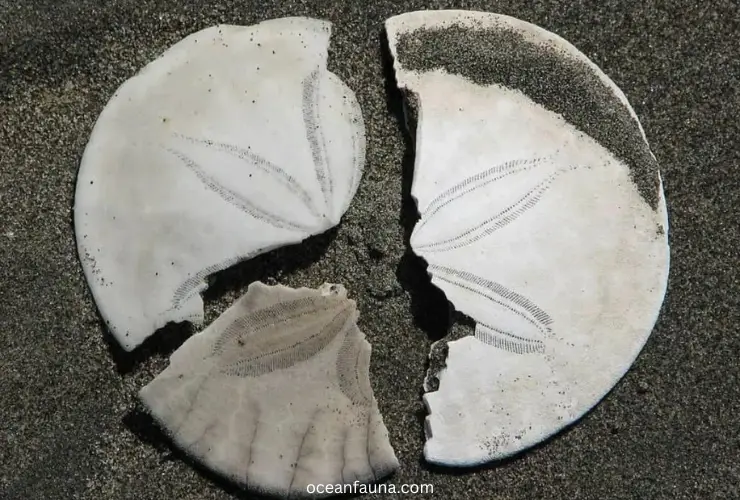Sand dollars have a hard outer shell made of calcium carbonate. Inside this shell, there are five tooth-like sections with 50 calcified elements in addition to sixty muscles. They also have complex systems of organs and tissues that allow them to survive.
Sand dollars are fascinating creatures found in oceans around the world. They are members of the echinoderm family, which includes sea urchins and starfish.
Sand dollars are known for their distinctive flattened circular shape and intricate pattern of petal-like structures on their surface. Let’s learn more about these creatures in this article!
Body Structure And Physical Features of a Sand Dollar
Body Structure of a Sand Dollar
What is the body structure of a sand dollar? Sand dollars have a flattened circular shape and a hard outer shell, or test, which is made up of calcium carbonate.
The top surface of the test is covered with small spines and petal-like structures arranged in patterns, which helps them to move and burrow in the sand.
Physical Features of a Sand Dollar
A sand dollar is a type of marine animal belonging to the echinoderm family, which also includes sea stars and sea urchins. The sand dollar gets its name from its round, flat shape and sandy color.
The physical features of a sand dollar include a flattened circular body that measures about 3–4 inches in diameter.
On the top surface, sand dollars have hair-like spines that allow them to breathe and move.
Sand dollars have a hard skeleton of calcium carbonate, giving them their distinctive shape and durability. This skeleton is covered with a layer of velvety skin that contains pigment cells responsible for their coloring.
Sand dollars also have a mouth on the bottom of their bodies, which they use to feed on tiny food particles such as algae, plankton, and detritus. ~ National Geographic
They can regenerate their limbs and spines, which allows them to recover from injuries and avoid predators.
They also use specialized tube feet to move along the ocean floor and capture food particles, such as algae and plankton.

What Does the Inside of a Sand Dollar Look Like?
When you break a sand dollar, you will find a white, powdery substance.
The sand dollar’s endoskeleton is composed of calcium carbonate plates that are fused together. These plates provide support and protection for the sand dollar’s internal organs.
The internal organs of a sand dollar include its digestive and reproductive systems.
Breaking a sand dollar can be harmful to the animal, as it can damage its endoskeleton and internal organs.
Note: Carefully handle sand dollars and only collect them from the beach if they are dead and washed up on shore.
A List of Organs Sand Dollar Has
- Mouth: The sand dollar’s mouth is located on the bottom surface of the body and is surrounded by five paired rows of tiny tube feet that help it to capture and transport food.
- Digestive system: The sand dollar has a complex digestive system that includes several stomachs and a long intestine. It feeds on small food particles such as algae, plankton, and detritus.
- Water vascular system: The sand dollar’s water vascular system is responsible for movement and respiration. It includes a series of canals, tube feet, and respiratory trees that help to circulate water and oxygen throughout the body.
- Reproductive organs: The reproductive organs of a sand dollar are located near the edges of the body and release eggs and sperm into the water for external fertilization.
The Story of the Sand Dollar And the Doves Inside
The story of the sand dollar and the doves inside is a popular Christian legend that suggests the sand dollar symbolizes the birth, crucifixion, and resurrection of Jesus Christ.
5 Doves in a Sand Dollar
According to the story, the five-pointed pattern on the surface of the sand dollar represents the Star of Bethlehem, while the dove-like shape inside symbolizes the Holy Spirit.
The small holes on the surface of the sand dollar are said to represent the wounds of Christ. Also, the flower-like pattern on the back is the Easter lily, symbolizing the resurrection.
While this legend is a beautiful and inspiring story, it is not based on scientific fact. Sand dollars do not contain doves or any other living creatures inside them.
When a sand dollar dies, its endoskeleton breaks into small pieces that can be washed up on shore and collected as beachcombing treasures.
Why Do Sand Dollars Have 5 Holes?
The skeleton of a sand dollar has a series of holes called petaloid. The feet of these organisms extend out of these holes. The five holes help the sand dollar breathe.

The bottom surface of a sand dollar is smooth and has a distinct flower-like pattern with five paired rows of tiny holes used for breathing and feeding.
Do Sand Dollars Have a Stomach?
Yes, sand dollars have a stomach and a complex digestive system with an upper and lower esophagus.
The sand dollar’s digestive system also contains enzymes. It breaks down the food into nutrients that the body can absorb and use.
Do Sand Dollars Have Blood?
No, sand dollars do not have blood or a cardiovascular system. Because they have a water-vascular system, they use seawater instead.
Instead, sand dollars have a circulatory system that includes a fluid known as “coelomic fluid,” which functions like blood in other animals.
The coelomic fluid circulates nutrients, oxygen, and waste products throughout the sand dollar’s body. This will help to maintain fluid balance and regulate body temperature.

Do Sand Dollars Have Tissues?
Yes, sand dollars have a tissue that makes up their body structure and allows them to perform vital functions such as movement, feeding, and reproduction.
The tissue of a sand dollar comprises various types of cells, including
- Muscle cells
- Nerve cells and
- Digestive cells.
Sand dollars also have connective tissue. These cells work together to form the complex systems and organs that allow the sand dollar to survive and thrive in its ocean habitat.
What is the Flower on a Sand Dollar?
The sand dollar’s distinctive five-pointed pattern on its surface is called a petaloid. It is made up of a series of pores and channels that are used for respiration, movement, and feeding.
The pores on the sand dollar’s surface absorb and expel water, which helps with gas exchange and circulation.
So, the flower on the sand dollar is its gills, which help it survive underwater.
Is a Sand Dollar a Bone?
A sand dollar is not a bone but rather an echinoderm, a type of marine invertebrate that includes sea stars, sea urchins, and sea cucumbers.
While the internal structure of a sand dollar may resemble bone or cartilage, it comprises a series of tiny skeletal plates held together by connective tissue.
These plates are covered by a layer of skin that is covered in tiny spines and tube feet, which the sand dollar uses for movement and feeding.

Do Sand Dollars Have Nerves?
Yes, sand dollars have a nervous system, which allows them to perceive and respond to their environment. They don’t have a brain, but a nervous system called a “nerve ring.”
The nervous system of a sand dollar is present around its pharynx. The nerve ring consists of interconnecting neurons and nervous tissues.
The nerves extend along the arms of sand dollars. These nerve cells transmit sensory information, coordinate movement and feeding, and regulate various bodily functions.
FAQs
Do sand dollars have muscles inside?
Yes, sand dollars have muscles inside their bodies for movement and feeding. The muscles are connected to the sand dollar’s internal skeletal plates and control the movement of the sand dollar’s spines and tube feet.
What are the little things inside a sand dollar?
The “little things” inside a sand dollar are the five-part symmetry pattern of the animal’s internal skeletal plates. These plates are arranged in a star-like shape and are connected by a thin layer of connective tissue.
What is the inside of a sand dollar called?
The inside of a sand dollar is typically called a “petaloid,” which includes the animal’s skeletal plates, arranged in a five-part symmetry pattern and connected by a thin layer of connective tissue.
Conclusion
Sand dollars are fascinating creatures found in oceans around the world. This round-shaped creature is indeed a fascinating ocean mystery to marine biologists. Unlike other sea creatures, they have special anatomy and physiology.
I hope this article clarified your confusion about sand dollars and their structure.


1 thought on “What Is Inside A Sand Dollar? Discover Its Anatomy ”